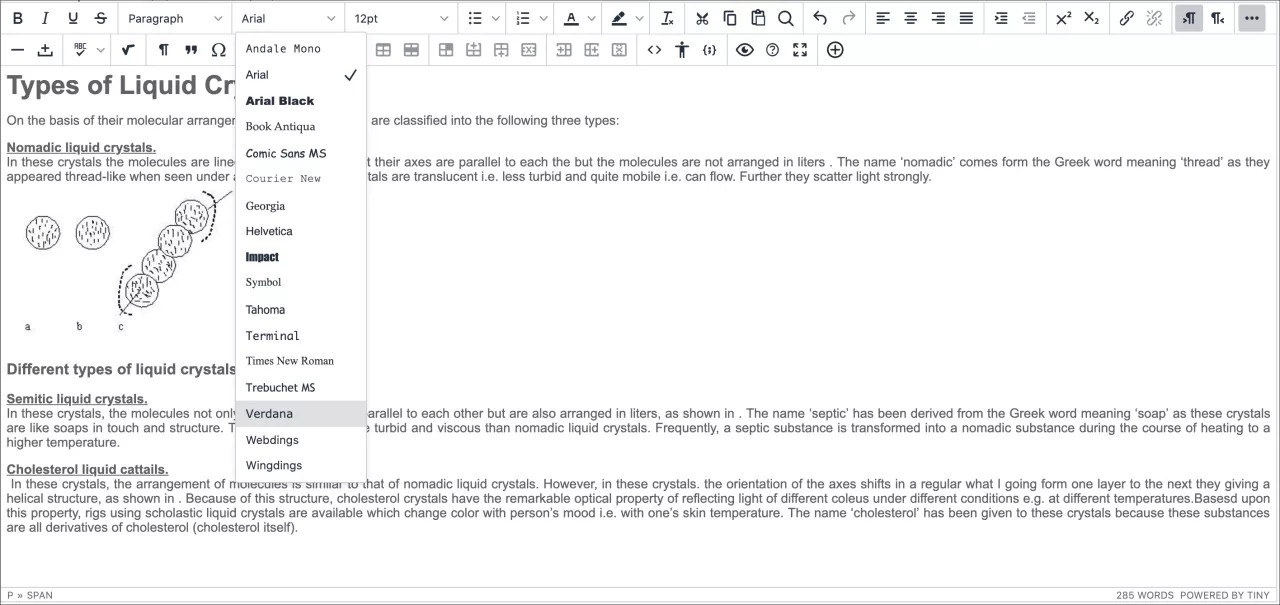The content editor is a platform-independent WYSIWYG editor based on TinyMCE and licensed as Open Source under LGPL from Moxiecode Systems AB. The content editor has a large number of new and enhanced features and serves as a replacement for the old text editor.
With the content editor, users can create professional, vibrant content wherever they can create blocks of text.
More on how students use the editor
More on how instructors use the editor
Summary of features in the content editor:
- Supported on nearly every major web browser currently available.
- Lightweight editing engine is much smaller and faster to load than most other web-based HTML editors.
- Users can switch between a compact single-line action bar containing only the basic formatting options, or an expanded action bar containing every available option.
- List numbering and bullet choices.
- Symbols, block quotes, horizontal rules, and emoticons.
- HTML and CSS (cascading style sheet) editing capabilities.
- Advanced table creation and editing controls.
- Advanced presentation and formatting controls for added objects.
- Expanded support for different file formats, including graphic images, media, mashup objects, and more.
- A single powerful but easy-to-use visual mathematics editor, the WIRIS Formula Editor, replacing both WebEQ and MathML.
The availability of the spell check and math editor features can't be modified at the environment, course or organizations level. This tool's availability is no longer customizable.
Configure the Math Editor Image Service
The WIRIS Formula Editor is a fully-featured mathematics editor which can enable users to compose formulas using a simple visual editing tool, and then embed these equations in the content as high-quality, compact .png images.
To configure the Math Editor Image Service, on the Administrator Panel in the Tools and Utilities section, select Math Editor Image Service.
The Math Editor Image Service page appears.
- Service Protocol: Select HTTP (unsecured) or HTTPS (secured).
- Host: Host name (should be the same as the server on which Blackboard Learn is installed).
- Image Service Port: The port number used (80 is the default).
- Service Path: The directory location on the host where math image files are rendered.
- Codebase Path: The directory location on the host where the math image service applet files are installed.
The Math Editor, created by WIRIS, is not currently accessible by screen readers.
Accessibility features
The accessibility features of the WIRIS editor make mathematics available to all users. The WIRIS editor takes advantage of the accessibility features in web browsers. Users don't have to install additional software to deliver content with accessible formulas.
More on displaying accessible math formulas
More on keyboard only and JAWS
Add new fonts to the content editor
You can add new font faces to the content editor expanding the ways text appears to users in a course. For example, you can add a special font face called Open Dyslexic to help students read more accurately. You can also add Greek and Hebrew fonts available from Biblestudytools.com so students can type with special characters in these languages. Adding font faces to the content editor provides new ways to format text anywhere in Blackboard Learn where the content editor appears.
A little planning and preparation ahead of time will ensure students and teachers can see and use new fonts in the content editor after you add them. All end users must have the fonts installed on their local computers. In some cases, users need to set the default font in their browsers to see new fonts. Before you add new fonts:
- Provide a way for users to download the fonts. You can provide links to download sites on the Internet or make the files available through the Content Collection.
- Provide clear instructions for Mac and PC users on how to install new fonts on their computers.
- Provide clear instructions for setting default fonts in Blackboard supported browsers.
After you have all your resources in place, you are ready to add fonts to the content editor. This is done by copying and editing a language pack. Language packs control all the text that appears in the Blackboard user interface. For instructions on how to add new font face options to a language pack, see Adding a New Font Face to the Content Editor.
After the new language pack has been edited and added back to Blackboard, you need to make it available in the system so students and teachers can select it for use in their courses. If you are not setting your edited language pack as the system default, provide your end users with instructions on how to set their Course Language Pack Preferences.
Adding new font faces to the Blackboard Learn content editor enhances the teaching and learning experience. New fonts stimulate creativity, provide ways to use other languages, and help your users read more accurately.
A brief note on spell check dictionaries
The need some users may have had years ago to add fonts isn’t valid today. Before the widespread adoption of unicode fonts, users used to load fonts for languages such as Chinese or Greek, or to support characters used in indigenous languages. The fonts used today support the necessary character sets across these languages, no longer necessitating the loading of special fonts for additional language support, therefore, multi-language support by loading custom spell check dictionaries is not longer provided with 3900.0+.
